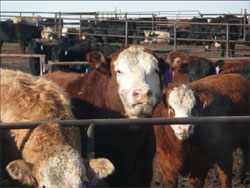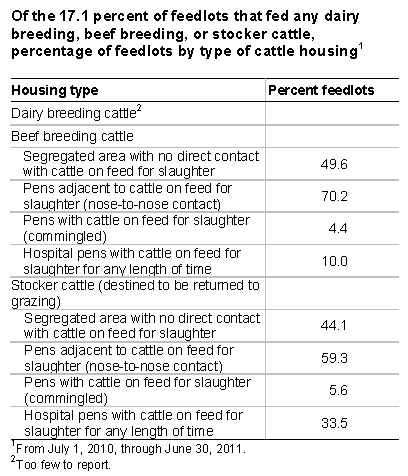



Biosecurity on US Feedlots
Biosecurity is a collection of management practices designed to minimise the risk of disease introduction and spread on an operation. Such practices may include: isolation of new arrivals, rodent control, equipment cleaning, and minimising visitor entry into pens. Because feedlots frequently obtain animals from more than one source, biosecurity practices are important in preventing disease introduction and spread.The US Department of Agriculture’s National
Animal Health Monitoring System (NAHMS) conducted
the Feedlot 2011 study, an in-depth look at large
feedlots (1,000 head or more capacity) in 12 States2
and small feedlots (fewer than 1,000 head capacity) in
13 States.3
Large feedlots accounted for 82.1 per cent of the
January 1, 2011, inventory of feedlot cattle in all US
feedlots but only 2.8 per cent of all feedlots. The 12
participating States accounted for over 95 per cent of the
inventory of cattle in large feedlots (NASS, “Cattle on
Feed” February 18, 2011). Small feedlots accounted for
16.0 per cent of the inventory on all US feedlots and
92.9 per cent of all US farms with cattle on feed. The 13
participating States accounted for 85.4 per cent of US
farms with fewer than 500 cattle on feed and 90.5
per cent of the inventory on farms with fewer than 500
cattle on feed (NASS, 2007 Census of Agriculture).
Study results presented in this information sheet reflect
only large feedlots,4 which were divided into two groups:
those with a capacity of 1,000 to 7,999 head and those
with a capacity of 8,000 or more head.
One objective of the Feedlot 2011 study was to
describe the current biosecurity practices and
capabilities of US feedlots. Biosecurity practices are
important in preventing the introduction and spread of
potentially catastrophic foreign animal diseases, as well
as managing endemic and epidemic domestic disease.
Understanding feedlot population characteristics and
common biosecurity practices can improve risk
evaluations and suggest intervention strategies for
particular diseases. Biosecurity practices examined
included housing management, vaccination protocols and disease testing, management of Mexican-origin
cattle, contact with other animals, visitor management,
equipment sharing and cleaning, information sources
and contacts in case of an outbreak, proximity to other
operations with livestock, and worker contact with
livestock on other operations.
Housing management

Feedlots, especially those with a capacity of 8,000
or more head, receive animals from many sources.
Animals that leave feedlots for purposes other than
slaughter represent a potential avenue for introducing
pathogens to breeding herds.
Overall, 17.1 per cent of feedlots had some animals
leave the feedlot and return to a breeding or stocker
operation. For feedlot animals destined to return to
breeding or grazing operations, biocontainment
practices—primarily segregation—could be one way to
mitigate the spread of certain pathogens.
Of these feedlots with beef breeding cattle and
stocker cattle, about half (49.6 and 44.1 per cent,
respectively) provided a segregated area that prevented
breeding and stocker cattle coming into direct contact
with cattle on feed for slaughter (see table). The majority of feedlots that fed any breeding
cattle (70.2 per cent) and that fed any stocker cattle (59.3
per cent) housed some of these animals in pens that
allowed nose-to-nose contact with cattle on feed for
slaughter. There were no substantial differences in
housing practices by feedlot capacity or by region.

Pathogen testing
Pathogen testing can be used to determine if cattle returning to breeding or grazing pose a risk of transmitting a disease to the herd of origin. Nearly onethird of feedlots (30.6 per cent) did some pathogen testing on beef animals destined to be returned to breeding.
Management of Mexican-origin cattle
Mexican-origin cattle in feedlots are thought to be at a higher risk of being infected with certain pathogens, such as Mycobacterium bovis. Overall, 12.5 per cent of feedlots fed any Mexican-origin cattle. A higher per centage of feedlots with a capacity of more than 8,000 head fed Mexican-origin cattle than feedlots with a capacity of 1,000 to 7,999 head (36.6 and 2.5 per cent, respectively).
Contact with other animals
Animals other than cattle can present biosecurity concerns. Other animals most commonly observed on feedlots were cats (77.2 per cent of feedlots); dogs (63.3 per cent) and horses, donkeys, mules, etc. (61.7 per cent). About 7 of 10 feedlots (72.8 per cent) also observed raccoons, squirrels, skunks, or rabbits on at least a monthly basis, and about 3 of 10 (33.5 per cent) observed wild ruminants.
Visitor management
Visitors can also present biosecurity concerns. The three most common classes of visitors included veterinarians, livestock haulers, and nutritionists (95.3, 91.8, and 89.0 per cent of feedlots, respectively). Overall, 25.1 per cent of feedlots displayed signage directing that visitors check with the office before entering the feedlot. Only 10.3 per cent of feedlots with a capacity of 1,000 to 7,999 head displayed such signage, compared to 60.6 per cent of feedlots with a capacity of 8,000 head or more. Most feedlots did not provide outer protective clothing or footbaths for visitors; however, 65.7 per cent limited access to animal areas, and 59.9 per cent restricted vehicles from animal areas. Restricting visitor access to animal areas was more common on feedlots with a capacity of 8,000 head or more (88.1 per cent) than on feedlots with a capacity of 1,000 to 7,999 head (56.3 per cent).
Equipment sharing and cleaning
Using the same equipment to handle manure and cattle feed can increase the risk of disease transmission. Pathogens can be transmitted from fecal material to cattle feed, and can be transferred from one pen to another via contaminated feed. Nearly 2 of 3 feedlots with a capacity of 8,000 head or more (64.8 per cent) never used the same equipment to handle manure and feed (see figure on next page). In contrast, 36.8 per cent of feedlots with a capacity of 1,000 to 7,999 head never used the same equipment for handling manure and feed. Approximately one of three feedlots with a capacity of 1,000 to 7,999 head (31.1 per cent) routinely used the same equipment for handling manure and feed. For feedlots that did use the same equipment to handle manure and feed, 81.1 per cent washed the equipment with water or steam and 6.3 per cent washed and chemically disinfected the equipment between uses.

Information sources and contacts in an outbreak
In the event of a foreign animal disease outbreak such as foot-and-mouth disease, communication with and notification of the proper officials are vital. Understanding which information resources feedlots would choose in the event of such an outbreak can facilitate the timely delivery of important information. Overall, 94.3 per cent of feedlots were very likely to contact their private veterinarian in the case of an outbreak of foreign animal disease.
Proximity to another operation with livestock
Direct contact with cattle from another operation poses a threat to cattle health and might increase the risk of disease spread. Relatively few (7.9 per cent) feedlots shared a fence line with a neighboring feedlot.
Labor
Employees that have contact with livestock on more
than one operation can be a biosecurity concern.
Contact with other livestock outside the feedlot was
minimal for about half of feedlots; 53.2 per cent of fulltime
employees who only handled cattle had no contact
with livestock on other operations, and
59.7 per cent of employees did not own any livestock.
2 Arizona, California, Colorado, Idaho, Iowa, Kansas, Nebraska, New
Mexico, Oklahoma, South Dakota, Texas, Washington.
3 Illinois, Indiana, Iowa, Kansas, Michigan, Minnesota, Missouri,
Nebraska, Ohio, Pennsylvania, South Dakota, Texas, Wisconsin.
4 Information on small feedlots is available at:
http://www.aphis.usda.gov/animal_health/nahms/feedlot/index.shtml


